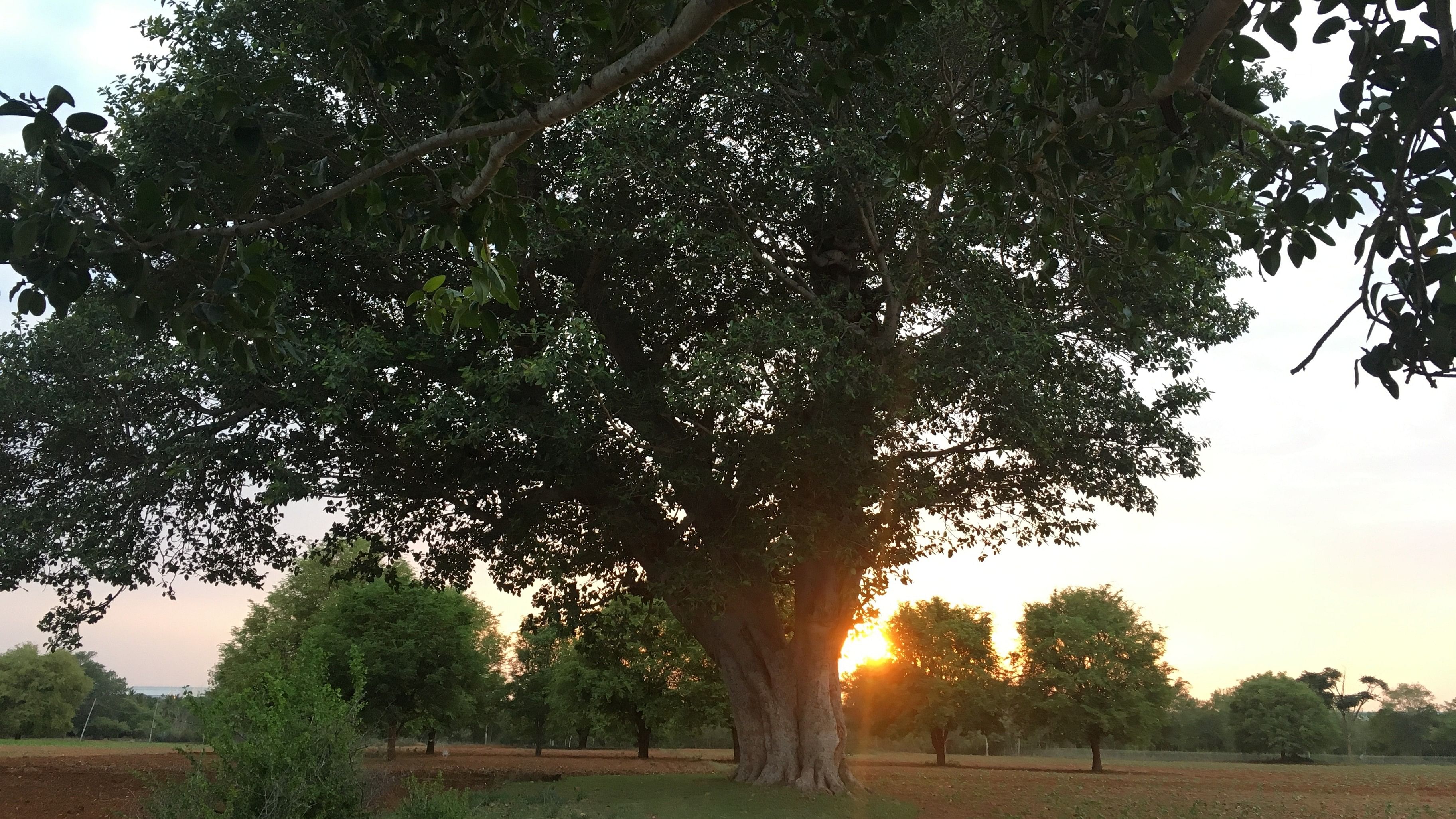
The regal banyan tree in Navilu Kaadu's neighbourhood.
Credit: Ramya Coushik
A regal banyan tree once towered over the fields in Navilu Kaadu’s vicinity. We spent idyllic evenings beneath its luxuriant canopy, the gnarled, knotty boughs stretched out against an expanse of lilac sky.
India’s national tree, the banyan (Ficus benghalensis), is one of more than 750 species of the genus Ficus, including the peepal tree (Ficus religiosa), weeping fig (Ficus benjamina), cluster fig (Ficus racemose), Indian rubber tree (Ficus elastica) and several others, all broadly called fig trees. Of these, the common fig (Ficus carica) is widely cultivated and consumed. Fig trees are considered keystone species, and sustain sizeable wild populations, more so during periods of scarcity, when food sources dwindle all around.
Hindu mythology appositely honours the banyan as the wish-fulfilling tree, exemplifying eternal life.
Our majestic banyan sprouted an unceasing banquet of bright red figs for its residents and wayfaring wildlings. We would pick up fallen centimetre-wide figs and look for tell-tale holes in them. Sometimes, we pried them open to espy the secret within — banyan flowers!
The figs of the banyan and other Ficus species are, in fact, inwardly turned inflorescences, called ‘syconia’, complete with numerous male and female florets. No bird, bee or bat can get to the hidden inflorescence…not even the wind.
So how does the secretive banyan pollinate and procreate? Sometime between 70 and 90 million years ago, during Earth’s Cretaceous period, nature picked a little creature and intertwined its fate with that of the mighty banyan, for coevolution over the aeons — the agaonid wasp (Eupristina masoni), commonly called fig wasp. Without this exclusive pollinator, the redoubtable banyan will go extinct. The same is true for the wee fig wasp. Each Ficus species has coevolved with a specific wasp species to support each other’s life cycles. One will go extinct without the other. Scientists identify this singular pact between the agaonid wasps and the fig trees, as ‘obligate mutualism’.
So, here’s the enthralling saga of the minuscule, millimetre-long agaonid wasp and Navilu Kaadu’s neighbourhood giant banyan. While the fig tree-fig wasp cycle is perpetual, let’s commence our story from when our banyan advertises its prime figs by floating a special scent for house-hunting female wasps. Somewhere out there, a pregnant female agaonid wasp carrying a gift of pollen from a far-flung banyan, and equipped with specialised odorant receptors to intercept the scent trail from the tree, follows it to a fig on our banyan tree. The fig or syconium, loosens an opening called ‘ostiole’, at its tip to let the pollen-laden female wasp through.
The wasp loses her wings as she squeezes into the fleshy syconium, never to leave its confines again. Once inside, she pollinates a few of the female florets and lays her eggs on a few others. This mother wasp then dies, and the fig digests her remains. The florets with the wasp eggs form galls or swollen structures.
In time, male wasps emerge from the galls. They are born blind, wingless, and never leave the fig, yet accomplish two important tasks — fertilising the yet-to-emerge female wasps inside their galls and chewing a hole through the fig for the fertilised females to fly out. During this time, female wasps emerge from their galls. The fig’s male florets are now mature and hold pollen. The fertilised female wasps gather the pollen and exit through holes in the syconium made by their gallant mates, seeking distant banyans awaiting their arrival, to start the cycle anew.
The fig’s female florets pollinated by the mother wasp produce a single seed each, that grows and ripens into plenty of fruits. Birds and mammals gorge on the ripe, fruit-heavy fig and disperse the seeds, propagating the banyan’s progeny in faraway realms.
Sadly, our grand neighbourhood banyan met with a barbaric end for ostensibly casting its shadow on the surrounding fields and shrinking crop yields. It lives only in memory. But its offspring is now rooting and thriving.
Rooting For Nature is a monthly column on an off-kilter urban family’s trysts with nature on a natural farm.
The author chipped away at a software marketing career before shifting gears to independent consulting and natural farming. She posts as @ramyacoushik on Instagram. Reach her at bluejaydiaries@gmail.com